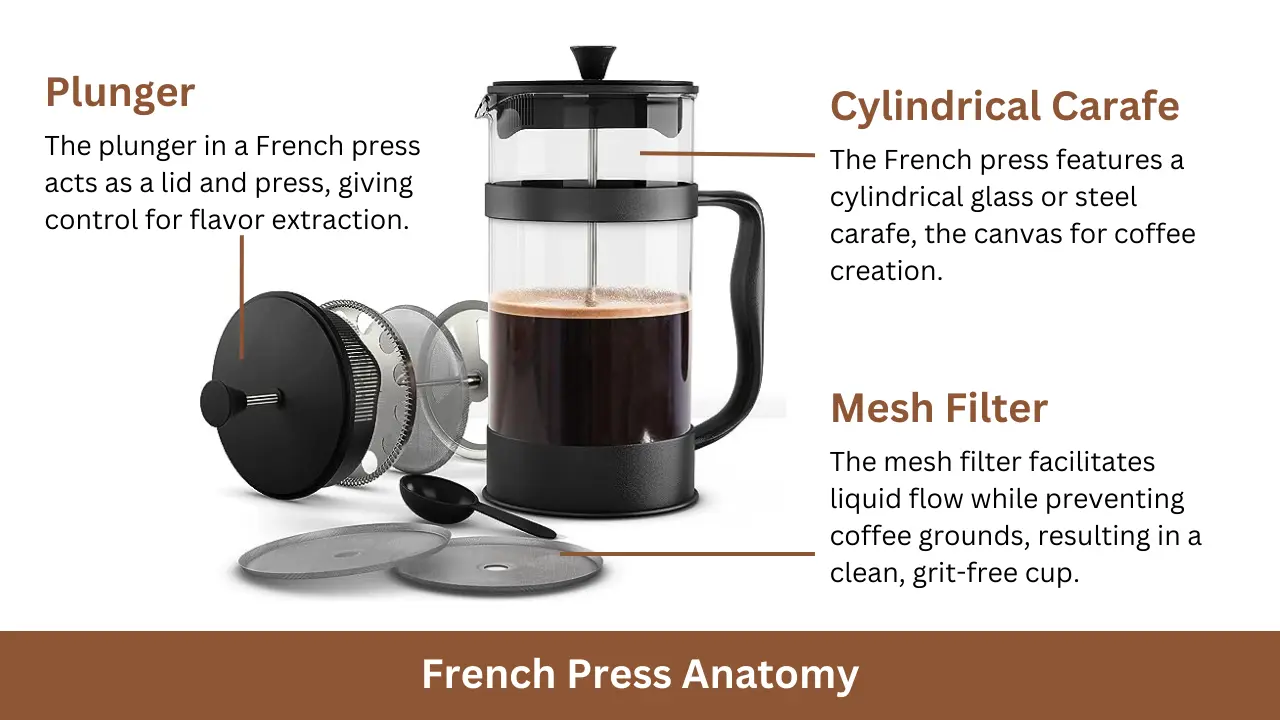Last Updated on September 19, 2023 by Timothy Byron Smith
Coffee enthusiasts understand that brewing the perfect cup of coffee is a craft worth mastering. Among the diverse methods of coffee preparation, the French press stands out as a beloved favorite, cherished for its ability to deliver a rich, full-bodied brew. In this comprehensive guide, we’ll delve deep into the world of French press coffee, sharing tips, troubleshooting advice, and creative uses that will elevate your coffee game to the next level.
Understanding the French Press
The French press, a revered manual coffee brewing device, offers coffee enthusiasts a unique and immersive experience. It comprises three essential components: a cylindrical carafe, a plunger, and a mesh filter.

1. Cylindrical Carafe
At its core, the French press boasts a cylindrical glass or stainless steel carafe. This vessel serves as the canvas upon which your coffee masterpiece is crafted, offering a generous space for the magic to happen.
2. Plunger
The plunger is a pivotal part of the French press, functioning as both a lid and a press. It’s a versatile tool that enables you to control the brewing process, allowing you to extract the full spectrum of flavors from your coffee grounds.
3. Mesh Filter
Nestled at the bottom of the French press, the mesh filter plays a crucial role in the coffee-making process. It allows the liquid to flow while effectively trapping the coffee grounds, ensuring a clean and grit-free cup of coffee.
In the world of coffee, the French press stands as a testament to the art of manual brewing. It’s a device that allows you to immerse yourself in the craft, where hot water and coffee grounds combine under manual pressure to produce a concentrated and deeply flavorful brew. As we continue this journey, we’ll unravel the secrets to mastering this extraordinary brewing method.
Perfecting the Coffee-to-Water Ratio for French Press
In the realm of French press coffee brewing, the art of achieving the perfect cup begins with mastering the coffee-to-water ratio. This foundational element is the compass that guides the strength, flavor, and overall profile of your brew. While the “golden ratio” of 1 gram of coffee to 17 grams of water serves as a trusted starting point, it’s essential to understand that the journey to coffee perfection is paved with opportunities for experimentation.
One of the fascinating aspects of French press brewing is its flexibility. Coffee-to-water ratios can be tailored to your preferences, allowing you to create a cup of coffee that resonates with your taste buds. For a standard brewed cup, consider a 1:15 ratio, translating to three tablespoons of coffee for every cup (8 ounces) of water. If you desire a more robust and intense brew, venture into a 1:12 ratio, with four tablespoons of coffee per cup.
Ultimately, the magic of the French press lies in its ability to adapt to your unique coffee ritual. Your palate and personal preferences are the ultimate guides on this journey, and the art of French press brewing invites you to experiment, explore, and savor every sip along the way. While crafting your own version you can calculate the French press ratio with the help of a French press ratio calculator.
Preparing for Brewing
In the pursuit of French press coffee perfection, meticulous preparation sets the stage for a remarkable coffee experience. Here’s how to lay the groundwork efficiently:
1. Freshly Roasted Beans
Your journey begins with quality coffee beans, ideally freshly roasted. Medium and dark roasts work wonderfully, imparting richness to your brew.
2. Grind Just Before Brewing
Grinding your beans just before brewing is essential for flavor preservation. While it adds a moment to your routine, it’s a vital step.
3. Coarse Grounds for Excellence
Opt for a coarse grind, akin to coarse sugar or sand. It ensures a full-bodied brew without bitterness. Burr grinders offer precision, but coffee shops can grind beans for you if needed.
4. Pre-Ground Considerations
Beware of espresso grind – it’s too fine for French press. Pre-packaged coffee may have overly fine grounds, impacting flavor. For the freshest, most flavorful results, grind your own beans and savor the difference.
Step-by-Step Guide to French Press Brewing
Crafting the perfect cup of French press coffee is a precise and rewarding process. This step-by-step guide combines the most effective techniques to help you achieve coffee perfection while keeping it concise:
Step 1: Prepare the Water
Start with fresh, filtered water and bring it to a rolling boil in your kettle. While the water heats, pour a small amount of hot water into the French press to warm it. Remove the kettle from the heat and let it sit for about 30 seconds to reach the ideal brewing temperature.
Step 2: Grind Your Beans
Grind your coffee beans just before brewing to preserve flavor. Aim for a coarse grind, similar to coarse sugar or sand. A burr grinder is ideal, but if you don’t have one, ask a coffee shop to grind beans for French press. Avoid fine espresso grind, which can lead to bitterness.
Step 3: Bloom Your Beans
Pour all the hot water (approximately 600 grams) over the coffee grounds to initiate the bloom. Let the coffee and water sit for about a minute to allow carbon dioxide to escape. This prevents interference with extraction and promotes better flavor.
Step 4: Stir and Steep
After the minute of blooming, gently stir the coffee to break the crust and ensure even saturation. Add the remaining hot water to reach your desired volume. Cover the French press without pressing down and let it steep for 3 to 4 minutes, depending on your taste preferences.
Step 5: Press and Serve
With steeping complete, slowly and firmly press the plunger to push the coffee grounds to the bottom. Adjust the grind if it’s too hard or too easy to press. Your French press coffee is now ready to serve immediately. If you’re not consuming it all at once, transfer the remaining coffee to a thermos or carafe to prevent over-brewing.
Enjoy your meticulously brewed cup of French press coffee, and feel free to adjust the process to your taste preferences with each brew.
Essential Equipment for French Press Brewing
To embark on your journey to French press coffee perfection, you’ll need the right equipment. Let’s dive into the essential tools that ensure a flawless brewing experience:
1. French Press
While any French press can brew a decent cup of coffee, some models stand out. The Bodum Chambord, with its classic design and simplicity, is a top choice. Its cylindrical carafe, built-in plunger, and mesh filter make it a reliable option for coffee enthusiasts.
2. Burr Grinder
Investing in a burr grinder is essential for unlocking the full potential of your coffee beans. Unlike blade grinders, burr grinders offer precise control over grind size, preserving the delicate aromas and flavors of the beans. The Baratza Encore Conical Burr Coffee Grinder is a notable example that offers a range of grind settings.
3. Electric Kettle
While precision pouring, as required by some coffee methods, isn’t crucial for French press brewing, a reliable electric kettle is still a valuable asset. The Zwilling Enfinigy Electric Kettle is an excellent choice. Its cool-touch feature ensures safety, and it has a hold feature that keeps the water hot for up to 30 minutes, offering added convenience.
These three equipment items form the foundation of your French press brewing setup. With a suitable French press, a quality burr grinder, and a reliable electric kettle, you’re well-equipped to embark on your journey to coffee perfection.
Beyond Coffee: Alternative Uses for Your French Press
Your French press is a versatile kitchen tool, and it’s not just for coffee. Here are some creative alternative uses:
1. Brewing Loose-Leaf Tea
Repurpose your French press to brew loose-leaf tea. Follow similar steps as coffee-making, substituting coffee grounds with tea leaves. Steep the tea in hot water, then press to separate the brewed tea from the leaves.
2. Filtering Stocks and Broths
Use your French press to filter stocks and broths by removing solid particles. Remember to clean the press thoroughly afterward to prevent flavor contamination.
3. Frothing Milk
Transform your French press into a milk frother for lattes and cappuccinos. Push the plunger up and down in the milk to introduce air, creating froth. It might take some effort, but the result is frothy milk for your favorite espresso-based drinks.
These alternative uses highlight the French press’s versatility in the kitchen, making it a handy tool for various culinary and beverage applications.
Troubleshooting Common French Press Coffee Issues
Even the most skilled coffee enthusiasts encounter issues with their French press brews from time to time. Here are some common problems and their solutions:
1. Avoid Over-Steeping
Leaving coffee in the French press after plunging can result in bitterness as more flavor notes are extracted from the grounds. To prevent over-steeping, transfer your brewed coffee into a decanter or mugs immediately after pressing.
2. Choose Your Coffee Wisely
Consider the type of coffee you want to brew. Heavy-duty filters, like those in some other brewing methods, offer more flavor clarity, making floral and light-roasted coffees shine. French press, with its metal filter, allows oils and sediment into your cup, giving a unique and full-bodied flavor, which pairs well with bold and dark-roasted coffees. Experiment with different coffee varieties to find your preference.
3. Clean Your French Press
Ensure thorough cleaning of your French press to prevent rancid or off-flavors. Dirty filters and old oils can lead to brewing problems, so regular cleaning is essential.
Remember that French press brewing offers flexibility and the opportunity to experiment with various variables like grind settings, water temperature, and coffee types. Adjust these factors to suit your taste preferences and enjoy the rich, full-bodied coffee that a French press can produce.
Conclusion
Mastering the art of French press coffee is a rewarding journey filled with rich, flavorful brews and endless possibilities for customization. Whether you’re a newcomer to this manual brewing method or a seasoned coffee enthusiast, the French press invites you to explore, experiment, and savor the unique experience it offers.
With the right equipment, precise techniques, and an understanding of the fundamentals, you can elevate your coffee game and enjoy exceptional cups of coffee tailored to your taste preferences. Embrace the versatility of your French press, and don’t hesitate to venture beyond coffee into the world of loose-leaf tea, frothy milk, and more. Your journey to coffee perfection awaits, and it begins with the French press in your hands.

